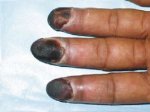Yeh, they're good with that kind of thing here in Australia. Americans would shit if they knew we can ring for free delivery of sharps 24/7

It's interesting to note that virtually every case study presented in this thread are either from the USA or Singapore. Go figure

Wow! That's really amazing! You guys have really got that public health thing going on. Apparently us Americans don't need to take care of our fellow man

The sad thing is that I've seen several people change their minds on universal healthcare when they, or someone they know can't afford to go to the doctor. Just switching sides out of convenience

Completely off topic, but really cool:
Rich Germans demand higher taxes
This really just blew me away. I wish more of the world could be like this. Realizing you have more, and giving it away to those less fortunate.
To be on topic, I have a contribution (if that's ok). Instead of looking at missed shots/bacterial in the shot, it is related to diseases of intravenous drug users, which can also be a big risk (although hopefully no one here shares any equipment. equipment includes cookers as you'll see!).
Prevalence of HIV-1 resistant to antiretroviral drugs in 81 individuals newly infected by sexual contact or injecting drug use
Salomon, Horacio; Wainberg, Mark A; et. al. AIDS: 28 January 2000 - Volume 14 - Issue 2 - pp F17-F23
Results:
A high prevalence of PI and RT genotypic variants, associated with
high-level resistance to antiretroviral drugs, was observed in individuals newly infected by injecting drug use (PI = 24%, RT = 24% ) or sexual transmission (PI = 12%, RT = 22% ). The PI mutations, L10I, V82A, and L90M, were found in 10.5, 3 and 4% of cases, respectively; whereas for RT, primary mutations at positions T215Y (zidovudine), M184V (lamivudine), T69D/A (zalcitabine), and K103N (multi-NNRTI) were present in 8, 5, 4, and 4% of subjects, respectively. Resistance to NRTI was demonstrated by phenotypic, genotypic, and line probe analyses. Transmission of
multidrug (NRTI/NNRTI/PI) resistance in eight subjects (9.9% ) was confirmed by showing that source partners possessed viruses of similar genotype.
Full article is free
here for those interested
Risk of Hepatitis C Virus Infection among Young Adult Injection Drug Users Who Share Injection Equipment
Lorna E Thorpe1,4, Lawrence J Ouellet1, Ronald Hershow1, Susan L Bailey1, Ian T Williams2, John Williamson3, Edgar R Monterroso3,5 and Richard S Garfein3
American Journal of Epidemiology Vol. 155, No. 7 : 645-653
Abstract:
Designing studies to examine hepatitis C virus (HCV) transmission via the shared use of drug injection paraphernalia other than syringes is difficult because of saturation levels of HCV infection in most samples of injection drug users (IDUs). The authors measured the incidence of HCV infection in a large cohort of young IDUs from Chicago, Illinois, and determined the risk of HCV seroconversion associated with specific forms of sharing injection paraphernalia. From 1997 to 1999, serum samples obtained from 702 IDUs aged 18–30 years were screened for HCV antibodies; prevalence was 27%. Seronegative participants were tested for HCV antibodies at baseline, at 6 months, and at 12 months. During 290 person-years of follow-up, 29 participants seroconverted (incidence: 10.0/100 person-years).
The adjusted relative hazard of seroconversion, controlling for demographic and drug-use covariates,
was highest for sharing "cookers" (relative hazard = 4.1, 95% confidence interval: 1.4, 11.8 ),
followed by sharing cotton filters (relative hazard = 2.4, 95% confidence interval: 1.1, 5.0).
Risks associated with syringe-sharing and sharing of rinse water were elevated but not significant. After adjustment for syringe-sharing, sharing cookers remained the strongest predictor of seroconversion (relative hazard = 3.5, 95% confidence interval: 1.3, 9.9 ). The authors conclude that sharing of injection equipment other than syringes may be an important cause of HCV transmission between IDUs.






 and infections that are still very active (and i'm sure that he could feel!). Unfortunately, I feel like its partially the worry of getting in trouble.
and infections that are still very active (and i'm sure that he could feel!). Unfortunately, I feel like its partially the worry of getting in trouble.